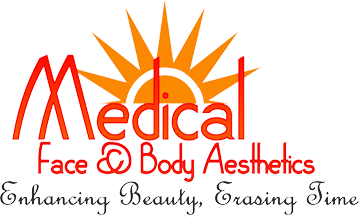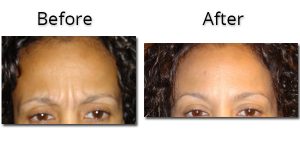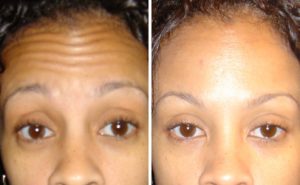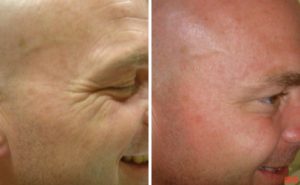What does Botox/Dysport treat?
Botox/Dysport is an increasingly popular procedure that can treat a variety of aesthetic and medical conditions, listed below. It is estimated that 20% of recipients are now men.
- Crow’s feet around the eyes
- Frown lines between the eyebrows
- Lines across the forehead
- Angry-looking eyebrows
- Pebbly or dimpled chin
- Excessive appearance of upper gums while smiling
- Excessive underarm sweating
- Bruxism (teeth clenching during sleep)
Before & After Photos of Our Patients
How safe is Botox/Dysport?
Botox/Dysport is very safe and well understood by medical experts. Botox/Dysport has been thoroughly tested for safety, and studies indicate that there have been no long-term complications or hazards with its use. Its effects are reversible and temporary, so even if the results are not exactly what you had hoped for, they wear off over a few months. A treatment consists of a small fraction of a vial of of Botox/Dysport, and it theoretically would have to take 35 complete vials injected into one person to have lethal consequences. As a precaution, I do not treat pregnant or nursing women with Botox/Dysport.
How is the Botox procedure performed?
After talking with us, and having a thorough examination of the area, we will discuss if you would benefit from an injection of Botox/Dysport, and if so, which sites would accomplish the result that you’re looking for. The procedure is generally performed with the patient sitting up in a chair, and the Botox/Dysport is injected very superficially under the skin using very fine needles, and it is virtually painless. Botox/Dysport prevents the appearance of wrinkles by relaxing the muscles used in certain facial expressions such as smiling, frowning, looking worried, or looking surprised. If the patient desires, a topical anesthetic can be applied prior to injection. Patients should not lie down for 3-4 hours after treatment, and should not rub the area of treatment during that time period. Other than that, patients can resume normal activity immediately.
Generally, the one-time treatment and visit will yield results lasting 3-5 months. You will see results anywhere from 24 hours to 14 days after the procedure. You may be asked to return for a 2-week follow up visit at no additional charge.



